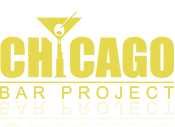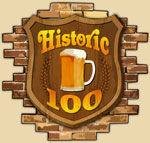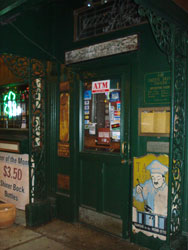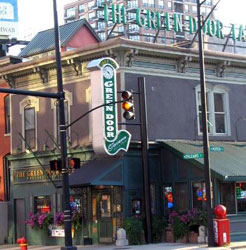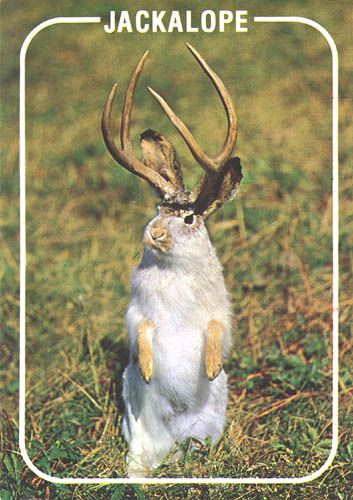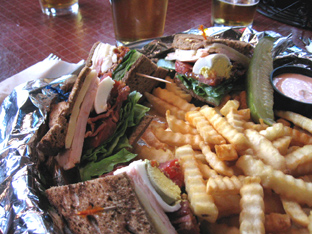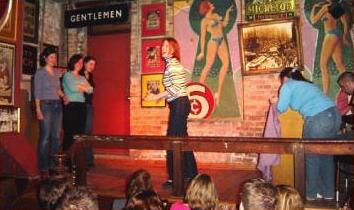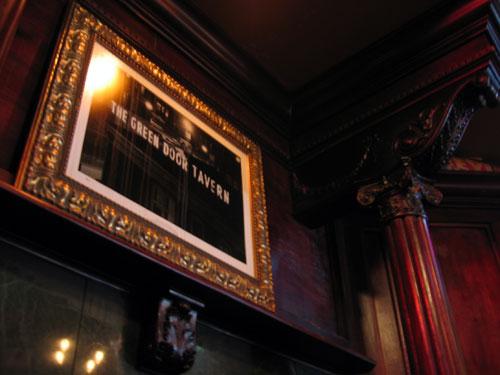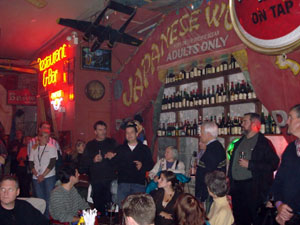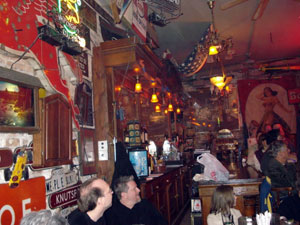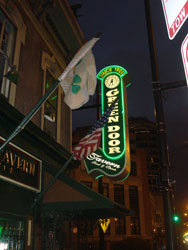 Though humbly named, the Green Door Tavern embodies old-school Chicago. In fact, the groggery resides in one of the first buildings to go up after the Great Chicago Fire of 1871 and was the last wood frame building allowed this close to the Loop after the Chicago City Council passed an ordinance banning this type of construction. The Green Door Tavern opened in 1921, made it through Prohibition as a speakeasy, and the building even survived a fire and car crash that took out the establishment’s northeast corner! Even with all that, the Green Door Tavern has been going strong for the better part of a century and still draws a healthy crowd of visitors and locals that come for a few beers and good selection of pub grub, and stay because they are bedazzled by enough Americana crammed into every nook and cranny as to make the Smithsonian envious.
Though humbly named, the Green Door Tavern embodies old-school Chicago. In fact, the groggery resides in one of the first buildings to go up after the Great Chicago Fire of 1871 and was the last wood frame building allowed this close to the Loop after the Chicago City Council passed an ordinance banning this type of construction. The Green Door Tavern opened in 1921, made it through Prohibition as a speakeasy, and the building even survived a fire and car crash that took out the establishment’s northeast corner! Even with all that, the Green Door Tavern has been going strong for the better part of a century and still draws a healthy crowd of visitors and locals that come for a few beers and good selection of pub grub, and stay because they are bedazzled by enough Americana crammed into every nook and cranny as to make the Smithsonian envious.
Old Chicago, Inside and Out
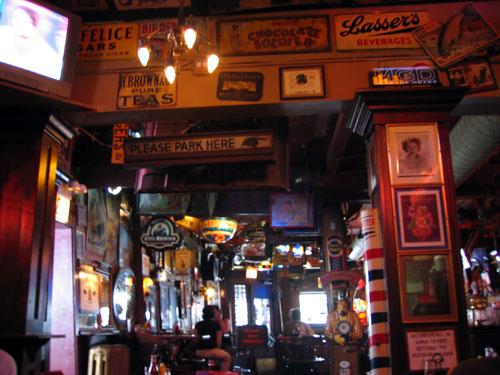 The Green Door Tavern is not to be confused with another Chicago legend, the Green Mill, located further north in Uptown, or Green Dolphin, another great jazz club in Lincoln Park. Rather, the Green Door Tavern is located in River North at the corner of Orleans and Huron, just west of the art gallery district and just south of another Chicago classic, Club Lago. You can’t miss the Green Door with its name spelled out in 6-foot tall green lettering placed on the roof and is illuminated at night, as well as with the long green sign with embedded clock. Because it has been settling for over 130 years, the whole wooden structure leans a bit, but what do you expect from a building that dates back to 1872? The façade of Green Mill is painted rather tastefully in—you guessed it—a green of the forest variety, with the second floor in what looks like a light purple or lavender and with the windows and roof accented in a tan color.
The Green Door Tavern is not to be confused with another Chicago legend, the Green Mill, located further north in Uptown, or Green Dolphin, another great jazz club in Lincoln Park. Rather, the Green Door Tavern is located in River North at the corner of Orleans and Huron, just west of the art gallery district and just south of another Chicago classic, Club Lago. You can’t miss the Green Door with its name spelled out in 6-foot tall green lettering placed on the roof and is illuminated at night, as well as with the long green sign with embedded clock. Because it has been settling for over 130 years, the whole wooden structure leans a bit, but what do you expect from a building that dates back to 1872? The façade of Green Mill is painted rather tastefully in—you guessed it—a green of the forest variety, with the second floor in what looks like a light purple or lavender and with the windows and roof accented in a tan color.
“If you can’t come in, smile as you go by,” cheerfully proclaims a sign over the newly attached green door, which stands next to a pair of windows partially obscured by flowers when the weather allows for it as well as wrought iron bars, reflective of the what the neighborhood used to be like prior to the destruction of most of Cabrini Green. A pair of flagpoles extend from the façade of the Green Door and sometimes one even has an American flag waving from it. Step through the tavern’s namesake door, and you’ll be overwhelmed with tavern-iana. The interior is absolutely choked with tchotchkes in a manner that not even the Burwood Tap, Butch McGuire’s or Chicago Joe’s can match, let alone the Axis of Evil (Bennigan’s, TGI Friday’s and Ruby Tuesday’s) with their manufactured kickshaws… At Green Door, you’ll find old-time advertisements, an Uncle Sam handshake machine, Budweiser clock with a mini-Clydesdales, Tiffany-style Schlitz hanging light, antique sporting equipment and musical instruments, black & white photographs, cute sayings, and even a barber pole, which are only some of the items hanging from the ceiling, the walls, the columns, and every other inch of space.
“Long before the fern bars on Division Street and the suburbs started raiding antiques shops for bits of faded Americana, this historic restaurant/tavern was filled to the rafters with timeworn relics. From ancient brass cash registers to vintage Ex-Lax and Ladies Home Journal ads, the Green Door presents a visual feast without coming off like a tourist trap.”
– Gayot’s The Best of Chicago (1995)
Bric-a-Brac and Pabulum
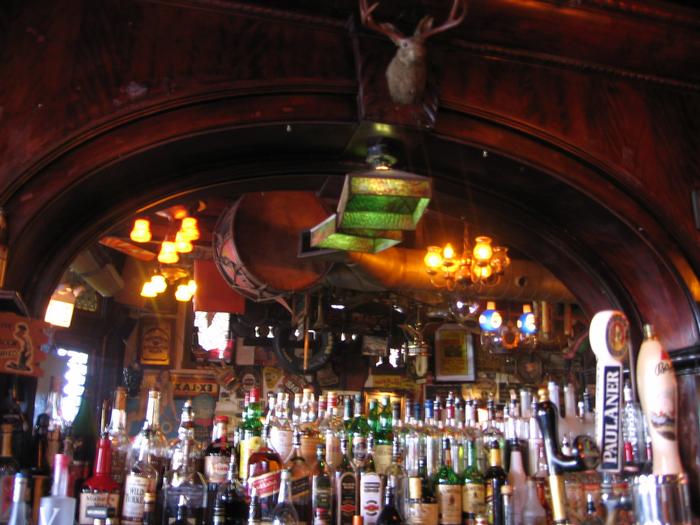 The bar, featuring its original triple-arched Brunswick woodwork, runs most of the way down the south wall of the front room and offers 10 beers on tap, including a well poured Guinness and Fat Tire, all from a brass fixture that matches the ancient cash register behind the bar that still promotes Schlitz for 5¢. “Cudthromach Aire,” meaning “public notice” in Gaelic is written upon a wooden sign hanging above the bar, from which small wooden tags illustrate how many days are left until St. Patrick’s Day. A series of flatpanel screens keep patrons entertained, placed on opposite sides of the large arched mirror behind the bar and elsewhere throughout the room. Added bonuses are the miniature Green Door Tavern replica placed above the wine glass rack at the end of the bar, a wooden carousel horse with a disco ball hanging from it, and the stuffed head of the mythical “Jackalope” above the bar.
The bar, featuring its original triple-arched Brunswick woodwork, runs most of the way down the south wall of the front room and offers 10 beers on tap, including a well poured Guinness and Fat Tire, all from a brass fixture that matches the ancient cash register behind the bar that still promotes Schlitz for 5¢. “Cudthromach Aire,” meaning “public notice” in Gaelic is written upon a wooden sign hanging above the bar, from which small wooden tags illustrate how many days are left until St. Patrick’s Day. A series of flatpanel screens keep patrons entertained, placed on opposite sides of the large arched mirror behind the bar and elsewhere throughout the room. Added bonuses are the miniature Green Door Tavern replica placed above the wine glass rack at the end of the bar, a wooden carousel horse with a disco ball hanging from it, and the stuffed head of the mythical “Jackalope” above the bar.
Seating can be had at high-backed wooden stools at the bar and at a series of cocktail tables across from it that are almost as popular. Additional seating can be found in back at a smattering of low-slung wooden tables with green tablecloths, with the ones in the very rear of the room, in the northwest corner, being placed in front of a recently added fireplace set within marble slabs and framed by two wooden pillars. Here you can watch the bustle of servers ascending and descending the ramp that leads to the kitchen in the rear. A portal halfway down the northern wall leads to the “sun room” where another half dozen or so low-slung tables can be found, set below hanging lights with tassels and amongst even more saloon-a-rama that vies for your attention along with windows offering views of the street life on Huron. A pool room can be found though a passage right before you reach the kitchen, back in the main room on the left. Here, you’ll also find a metal staircase leading down to the restrooms, a scale where you can weigh yourself for a penny, and the silver-curtained entrance to a room of exposed brick where the speakeasy was operated and which was prominently featured on the second Chicago History Museum Pub Crawl in 2007, led by yours truly.
“Tipping is not a town in China”
– sign above the brass bell, rung when tips are left
The Green Door Tavern serves up a good selection of pub grub, highlighted by the bleu cheese burger, fish & chips, crab cake sandwich, ribs (dinner only), buffalo chicken sandwich, triple-decker grilled cheese, chili, and meatloaf. All food is served on circular metal beer trays lined with foil, and most orders come with heavily salted crinkle cut fries. The food isn’t cheap as the Green Door charges everyone tourist prices. According to the 2005/2006 edition of Zagat’s restaurant survey, a meal with a few beers will set you back about $18, but that is actually reasonably priced given what everyone else charges in River North. The service can best be described as having, “a lazy diligence about them,” according to Adam Payne of Centerstage Chicago.
“Bringing ‘a little bit of Greenwich Village to Chicago’, this former speakeasy in River North shows its age (almost 80) with out-of-plumb floors and doorways; menuwise, it sticks to ‘ok bar food’ of the ‘burger-and-beer’ variety, but its ‘landmark’ status means the room provides, ‘plenty to look at.'”
– Zagat Survey Chicago Restaurants (2002)
Patronage and The Ol’ Landmark
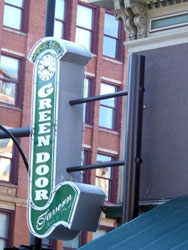 Because you’ll find it in every Chicago travel guide, the Green Door has become a bit of a tourist trap with both travelers, conventioneers and those venturing into the city from the suburbs. The Green Door is also popular with local art gallery types at lunchtime, suits for after-work cocktails, and with recent condo dwellers new to the area needing a place to watch the game. Also descending upon the Green Door are those taking seminars at nearby Landmark Education, who might not be taking everything in as usual because they are instead focused on giving up their rackets and acts, and establishing their new possibilities. If you overhear some unusually candid conversations between small yet diverse groups of people that look like they might not normally hang out together, chances are you’ve found those taking a Landmark seminar, particularly on nights between Thursday and Sunday.
Because you’ll find it in every Chicago travel guide, the Green Door has become a bit of a tourist trap with both travelers, conventioneers and those venturing into the city from the suburbs. The Green Door is also popular with local art gallery types at lunchtime, suits for after-work cocktails, and with recent condo dwellers new to the area needing a place to watch the game. Also descending upon the Green Door are those taking seminars at nearby Landmark Education, who might not be taking everything in as usual because they are instead focused on giving up their rackets and acts, and establishing their new possibilities. If you overhear some unusually candid conversations between small yet diverse groups of people that look like they might not normally hang out together, chances are you’ve found those taking a Landmark seminar, particularly on nights between Thursday and Sunday.
Speaking of Landmark Education, I have successfully completed their “Curriculum for Living,” which is a triumvirate of seminars comprised of the Forum, the Advanced Course, and the Self-Expression and Leadership Program. There is a lot of bad publicity about Landmark on the web, all of which seems to be from people that have heard things on a secondhand basis only. Landmark does offer something very different from what you’ve ever experienced, and can thus be easily misunderstood. It’s kind of like taking the red pill in The Matrix – and the Wachowski Brothers should know, they’ve successfully completed Landmark’s “Curriculum for Living” program as well… To my mind, Landmark is all about taking responsibility for your life and giving up those things in your mind that hold you back from living a life you love. For me, I realized from the Landmark seminars why I had become conflictive, confrontative and, at times, outright paranoid. Landmark gave me a way to get beyond that. The Landmark Forum helped me get past that point in my life where I couldn’t leave the house without being so insecure that it made walking down the street difficult and relationships impossible. Though the Forum did not lead me directly to the love of my life, I felt more confident about myself which ultimately led me to marry my wife and, after five years of marriage, people still ask us if we are newlyweds. The Advanced Course helped me understand what was holding me back from having successful and satisfying personal and business relationships. The Self-Expression and Leadership Program really put me on the path to independent success. I have started my own business, have re-established and dramatically improved relationships with my immediate family and close friends, and I am now doing things that I love to do (look for a book based on the Chicago Bar Project to come out soon…), and for things I really don’t want to do, I now tackle them first rather than procrastinate, which I could easily do for years… If you want to know more about Landmark, just shoot me an e-mail. Now, back to the Green Door Tavern…
“Charming, historical place that soaks its upscale patrons for all they’re worth. Everything is priced a dollar or two more than you’d pay elsewhere in River North.”
– The Official Chicago Bar Guide (1994)
After the Fire
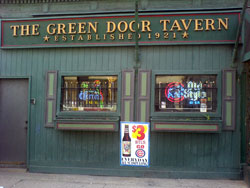 The building housing the Green Door Tavern was built in 1872 by James McCole and was originally rented to Lawrence P. Elk, who operated a grocery store out of it and lived above. Sometime shortly thereafter, the building started to lean and has remained that way ever since. In 1921, Vito Giacomoni opened the Huron-Orleans Restaurant here, which became famous for the patrons it served. The Huron-Orleans was then passed to sons Jack and Nello, who operated the basement as a speakeasy during Prohibition – one of the first in the downtown area, which attracted a clientele partially comprised of Chicago gangsters. The nickname “Green Door” came into use during the 1930s, stuck, and the establishment ultimately adopted its current name at some point through the years. Not only was the front door green (not the current entrance, but one formerly on the south end of the building), but a “green door” was also used as a euphemism for “speakeasy.” As the neighborhood declined, the place was described in the 1970s as, “not the kind of place one would bring a proper lady,” and in August 1985, George Parenti bought the place from the Giacomoni Brothers and filled it with much of décor found on the walls today. He also found an old ledger from the Prohibition Era that listed milk for $12.50, cheese for $22.50, and root beer for $625.00. According to Parenti: “I had an idea that that wasn’t really root beer!” Since then, the building survived a blaze in 1989, the residential building boom that transformed many of the other old buildings in the River North area, a car crash a few years ago that took out the entire entrance of the bar, and patronage from former Chicago Bull, Dennis Rodman, who used to have dinner at the tavern before every Tuesday game. The bar’s manager Pauli told me a funny story about Rodman: nicknamed “The Worm,” one of the Green Door staffers once told the old owner’s wife that “The Worm” was here on one of his nights. Not being familiar with the nickname, she went into a tizzy in an attempt to find the offending insect. “Apparently, the owner’s wife is not a fan of The Worm,” was Rodman’s response. Bill Kurtis has also been a regular at the Green Door Tavern as his studio, Kurtis Productions, is located right behind the saloon.
The building housing the Green Door Tavern was built in 1872 by James McCole and was originally rented to Lawrence P. Elk, who operated a grocery store out of it and lived above. Sometime shortly thereafter, the building started to lean and has remained that way ever since. In 1921, Vito Giacomoni opened the Huron-Orleans Restaurant here, which became famous for the patrons it served. The Huron-Orleans was then passed to sons Jack and Nello, who operated the basement as a speakeasy during Prohibition – one of the first in the downtown area, which attracted a clientele partially comprised of Chicago gangsters. The nickname “Green Door” came into use during the 1930s, stuck, and the establishment ultimately adopted its current name at some point through the years. Not only was the front door green (not the current entrance, but one formerly on the south end of the building), but a “green door” was also used as a euphemism for “speakeasy.” As the neighborhood declined, the place was described in the 1970s as, “not the kind of place one would bring a proper lady,” and in August 1985, George Parenti bought the place from the Giacomoni Brothers and filled it with much of décor found on the walls today. He also found an old ledger from the Prohibition Era that listed milk for $12.50, cheese for $22.50, and root beer for $625.00. According to Parenti: “I had an idea that that wasn’t really root beer!” Since then, the building survived a blaze in 1989, the residential building boom that transformed many of the other old buildings in the River North area, a car crash a few years ago that took out the entire entrance of the bar, and patronage from former Chicago Bull, Dennis Rodman, who used to have dinner at the tavern before every Tuesday game. The bar’s manager Pauli told me a funny story about Rodman: nicknamed “The Worm,” one of the Green Door staffers once told the old owner’s wife that “The Worm” was here on one of his nights. Not being familiar with the nickname, she went into a tizzy in an attempt to find the offending insect. “Apparently, the owner’s wife is not a fan of The Worm,” was Rodman’s response. Bill Kurtis has also been a regular at the Green Door Tavern as his studio, Kurtis Productions, is located right behind the saloon.
Green Door Tavern Findings
Back at the Green Door Tavern, you’ll find an easygoing watering hole full of American pop culture. The public house is not only a historical Chicago landmark by having been built just months after the Great Chicago Fire and being the only wood frame building anywhere near downtown, but the Green Door also doubles as a popular neighborhood sports bar and haven for travelers. The pub grub is as satisfying as the beer selection and their Bloody Mary concoction, and you’re set if you can snag a stool at the bar. If that isn’t enough for you, they even host comedy in the speakeasy room every Friday. You know you’re turning into a regular when you start thinking that the building’s skew is starting to straighten itself out… The Green Door Tavern once had a website but there’s no sign of it now, so you’ll have to call the number listed above for more information. For more information, check out the Green Door Tavern website. Until then, I recommend the red pill…
“The tavern stops just short of being a parody of itself, and the hordes of upscale patrons enjoy the burgers, salads and pasta.”
– Lonely Planet Chicago (2001)


